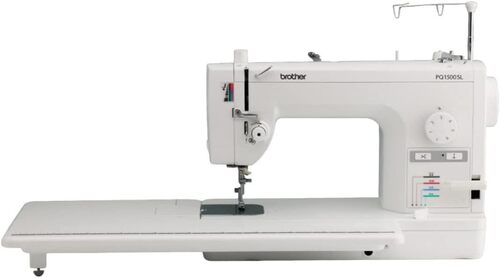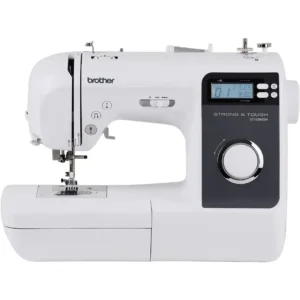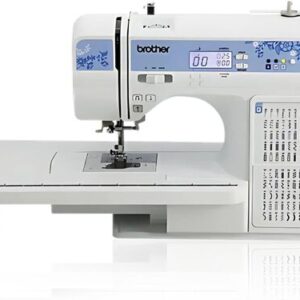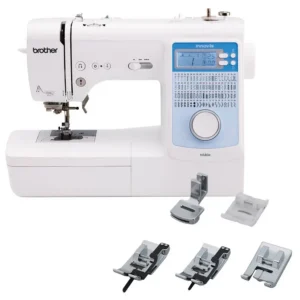
Why I Picked the Brother PQ1500SL
I still remember the thud on my porch when the delivery guy set down the box with “Brother PQ1500SL” stamped in bold on the side. For weeks I’d been buried in Brother PQ1500SL reviews, comparing it to the Juki twins and watching late-night videos of people quilting whole queen tops like it was nothing. My old machine had started wheezing at the sight of heavy denim, so I wanted something fast, tough, and simple. No screens. No songs. Just stitch.
Unboxing: Built Like a Workhorse
Unboxing felt like opening a toolbox more than a toy. The machine is heavy in that reassuring “this won’t walk across the table” way. Under the packing foam were the extension table, a small army of feet (walking foot, ¼” piecing foot, zipper feet, a free-motion foot), the knee lifter, and that tall thread stand that whispers, “Feed me big cones.”
First Look: Big Throat, Zero Fuss
First impression at the table? Big throat space. It looked like parking a small car under the arm compared to my old machine. I set on the extension table, plugged in the foot pedal, and had a tiny moment of panic: this is a straight-stitch only, semi-industrial style machine. Was I in over my head?
Threading & Setup Tips for the PQ1500SL
Threading took me a couple of tries, mostly because my hands kept forgetting one crucial rule: presser foot up while you thread. That opens the tension discs. Once I did that, the path clicked (literally — there’s a satisfying bobbin “click” when the case is seated right). The automatic needle threader and I had a rocky start. The trick for me is to bring the lever down, keep a little gentle tension on the thread, and let the tiny hook do its thing. If I’m tired, I just hand-thread and move on. No drama.
First Test Drive: Speed, Control, and Power
My first test drive was a denim tote. I eased onto the foot pedal like it was a gas pedal in a sports car — because honestly, the Brother PQ1500SL Sewing Machine is fast. There’s no speed slider; your ankle is the speed control. But the pedal is sensitive in a good way. I could creep stitch-by-stitch around corners, then zoom down long seams. The motor sounded smooth, confident. When I hit a thick, lumpy seam, I lowered the presser foot pressure a hair and flipped on the pin-feed system (that little needle-like helper under the foot). The machine just climbed and kept going. No clunk, no groan, no skipped stitches. It felt like I had a tiny bulldozer under the hood.
Game-Changer Features: Knee Lifter + Needle-Down
Then I tried the feature that made me grin like a kid: the knee lifter. Why did no one tell me this is life-changing? Both hands stay on the fabric while your knee taps to raise the foot for pivoting. Combine that with the needle-down setting and you feel like you’ve suddenly grown a third hand.
Quilting Trial: Walking Foot, Pin Feed & FMQ
Day two was the real test: quilting a big flannel-backed throw that had bullied my old machine. I set up with the walking foot, dropped the feed dogs one notch to make the glide just right, and rolled half the quilt into the throat without wrestling it. The extra space feels like a deep breath for your shoulders. Long straight lines melted into the fabric. When I wanted to get fancy, I switched to free-motion and played with loops on a practice sandwich. It took some doodling to dial in the tension (my best combo was a fresh 90/14 needle and good quality thread top and bobbin), but once it locked in — chef’s kiss.
Honest Bits: Real-World Quirks to Expect
Now for the honest bits — because this is a real-life Brother PQ1500SL review, not a fairy tale:
The thread cutter is brilliant… most of the time. If I cut with no slack, it snips a little short and the needle can unthread. My fix: raise the presser foot first and pull a whisper of slack, then tap the cutter. Since learning that, it’s been my favorite button again.
The side-loading bobbin is old-school. It’s not hard, just different. I can’t see how much thread is left, so I keep a couple of wound bobbins ready. The “click” when the case seats is the sound I wait for.
The built-in needle threader works, but it’s touchy with cheap or fluffy thread. When I’m using lovely smooth thread, it’s fine. On hairy bargain cones, I usually thread by hand and keep sewing.
The light is okay, not runway-bright. I stuck a small LED strip under the arm and now it’s daylight in my stitch zone.
Heavy Materials, No Drama
Somewhere around week three I got brave and made a vinyl-trimmed bag. I swapped to a non-stick foot, bumped the stitch length, and let the PQ chew through layers of canvas, foam, and faux leather like it was quilting cotton. If you’ve ever white-knuckled through a thick seam praying your needle wouldn’t snap, this machine will feel like you’ve unlocked a cheat code.
Six Weeks In: Piecing Fast, Quilting Clean
Six weeks in, I tackled a queen quilt. I pieced at rabbit speed — the ¼” foot on this machine is dead-accurate — then quilted straight lines with the walking foot. When I bound the edges, I appreciated how precise the pedal control is at slow speeds. Start, stop, pivot, zip. Clean, even stitches front and back.
Care & Feeding: Maintenance Made Simple
Maintenance is simple: brush out lint, a few drops of oil where the manual shows, new needle often. Every time I give it a little TLC, it purrs. And yes, it’s heavy. That’s part of why it stays put and doesn’t shake the table when you let it stretch its legs at 1,500 stitches per minute.
Straight Talk: Pros, Cons, and Who It’s For
If you’re sorting through Brother PQ1500SL reviews trying to decide, here’s my straight-talk:
What I love
• Straight stitch perfection at any speed — piecing looks professional.
• Power for days: denim, cork, canvas, batting stacks… it just goes.
• Big throat space + included extension table = less quilt wrestling.
• Knee lifter, needle-down, thread cutter — true time savers.
• Walking foot, pin feed, adjustable presser foot pressure for tricky fabrics.
What to know before you buy
• It’s straight-stitch only. I kept my older machine for zigzag/buttonholes.
• No speed slider. Your foot controls it, and you get used to it fast.
• Needle threader and cutter have a learning curve. Once you know the quirks, they’re assets.
• Side-loading bobbin with no “low bobbin” warning. Keep spares ready.
Final Word: My Brother PQ1500SL Review
Was it worth it? Absolutely. The Brother PQ1500SL has turned my sewing corner into a tiny, happy workshop. It’s the machine I turn on when I want to get real work done — quilts, bags, home projects, hems — without babysitting every stitch. If you’re hunting for a simple, strong partner and your heart beats a little faster when someone says “workhorse,” this is the one. So here’s my final word for the search engines and the sewists who read them: if you’re looking for a genuine, hands-on Brother PQ1500SL review written by someone who actually sews on it daily, this is it. The Brother PQ1500SL Sewing Machine does one thing and does it beautifully. And if you’re deep in the rabbit hole of Brother PQ1500SL reviews like I was, consider this your sign to climb out, clear your table, and start stitching.
What owners consistently praise and critique about the Brother PQ1500SL Sewing Machine?
| Pros | Cons |
|---|---|
| Power & speed: industrial-like straight stitching that flies through long seams and thick stacks (denim, canvas, vinyl, cork, batting). | Finicky needle threader: many say it’s awkward, shreds thread, or they just hand-thread instead. |
| Excellent stitch quality: very even, professional straight stitches once threaded/tensioned correctly. | Thread cutter trims too short: can unthread the needle unless users add slack or lift the presser foot first; a few wish they could disable it. |
| Big throat/harp + extension table: much less “quilt wrestling”; comfortable for king/queen quilts and large projects. | Side-loading bobbin: hard to see/reach, no low-bobbin warning, smaller capacity; learning curve to seat it until it “clicks.” |
| Feeds tricky materials well: adjustable presser-foot pressure, multi-level feed dogs, pin feed, and effective walking foot. | No speed slider: pedal-only control is very sensitive; machine is extremely fast — steeper learning curve for beginners. |
| Knee lifter & needle down: major workflow boost for pivoting and accuracy; many call these must-have features. | Tension can be picky: threading path must be exact; mixed thread types/weights can cause nesting until settings are dialed in. |
| Heavy, stable build: minimal vibration; generally smooth and quiet at normal speeds. | Lighting is dim: numerous buyers add an LED strip for better visibility. |
| Great for quilting & bags: sails through multilayer quilts, upholstery, and bag-making materials. | Straight-stitch only: no zigzag, buttonholes, or free arm — most owners keep a second machine for that. |
| Value vs. rivals: often compared favorably to Juki/Baby Lock equivalents at a lower price; “workhorse” reputation. | Documentation gaps: manual feels thin — many rely on YouTube for setup, threader tips, and FMQ tuning. |
| High-shank compatibility: accepts many industrial feet; accurate ¼″ foot included; easy bobbin winding. | Occasional QA/maintenance notes: reports of squeaks, one pin-feed failure, rare motor/warranty frustrations, and sometimes missing parts (e.g., knee lifter). |
| Versatile pace control via pedal: can stitch one-by-one for precision or rip at full speed when desired. | Noisy at top speed & heavy to move: some note “warehouse” vibes when flat-out; weight aids stability but hurts portability. |
| FMQ capable: with tuning and the right foot/thread, owners report smooth free-motion quilting. | Stock FMQ foot not loved: several upgraded to an open-toe or different brand FMQ foot for better results. |
Brother PQ1500SL — Your Most-Asked Questions Answered
What is the Brother PQ1500SL and who is it for?
The Brother PQ1500SL is a high-speed, straight-stitch sewing and quilting machine designed for power, precision, and a roomy work area. It is ideal for quilters and sewists who want fast, even stitches, a knee lifter, a large extension table, pin feed for tricky fabrics, and an automatic thread cutter. This quick Brother PQ1500SL review summary: it is a purpose-built straight-stitch workhorse rather than a decorative-stitch machine.
How fast is the Brother PQ1500SL Sewing Machine?
It sews up to 1,500 stitches per minute. Speed is controlled by how much you press the foot controller, so you can go very slow or very fast as needed.
Does the Brother PQ1500SL do zigzag or decorative stitches?
No. The Brother PQ1500SL Sewing Machine is a straight-stitch only model with adjustable stitch length up to 7 mm. Keep a secondary machine if you need zigzag or buttonholes.
What comes in the box?
Included accessories are generous: knee lifter, large fabric extension table, walking foot, free-motion quilting foot, 1/4 inch foot, invisible zipper foot, zipper foot, rolled hem foot, general purpose foot, seam guide, fabric separator, pin feed foot (pre-installed), feed pin and changer, 5 bobbins (SA159 in the Americas), spool net, screwdrivers, cleaning brush, and a soft cover.
What bobbins and needles does the Brother PQ1500SL use?
Use SA159 bobbins (Americas) and the included bobbin case. For needles, HLX5 sizes #9–#18 are recommended; Schmetz 130/705H #65–#110 can also be used under normal conditions.
How do I wind and install the bobbin?
Raise the thread guide bar, follow the bobbin-winding thread path, seat the bobbin on the winder with the notch aligned, and wind. To install, open the side bobbin door, insert the bobbin in the bobbin case, lock the case into the shuttle, then use the Quick Bobbin Thread Device to cut and hold the tail so you do not have to manually draw it up. Always use the supplied bobbin case.
How does the automatic needle threader work?
Raise the needle to its highest position, lower the presser foot, pull the thread forward, lower the threader, catch the thread on the hook, then release to pull a loop through the eye. Note that the threader cannot be used with some thread-needle combinations; transparent nylon can be used with a #14 or #16 needle.
The thread cutter leaves a short tail. How do I avoid unthreading?
Follow the built-in steps: press the thread cutter button while the presser foot is down, then raise the foot and remove the fabric. Start new seams with adequate top-thread slack and the correct thread path and tension. This simple routine minimizes short-tail unthreading reported in many Brother PQ1500SL reviews.
Does the PQ1500SL have needle up or needle down?
It has a Needle Stop Position button. When the light is on, the machine stops with the needle down in the fabric; with the light off, the stop position is random.
Can I adjust feeding for velvet, leather, or layered quilts?
Yes. You get four feed-dog heights plus a Pin Feed mode that lifts a small pin through the fabric to move layers evenly. Coordinate feed-dog position with the color-coded presser-foot pressure dial. The feed pin automatically lowers when the presser foot is raised for safety.
Is there a speed limiter slider?
There is no separate speed slider. The Brother PQ1500SL review consensus and the manual both emphasize using the foot controller to vary speed smoothly from very slow to very fast, up to 1,500 SPM.
How big and heavy is the Brother PQ1500SL?
It weighs about 11 kg (24 1/4 lb). Bed dimensions are about 17 1/4 x 7 inches, and the overall sewing area with table is about 23 3/8 x 11 1/4 inches for roomy quilt support.
How do I set up for free-motion quilting or use the walking foot?
For free motion: lower the feed dogs and reduce foot pressure, then install the free-motion quilting foot. For the walking foot: attach the forked lever around the needle-bar screw, tighten firmly, and sew at moderate speed (about 500 rpm or less). Do not use Pin Feed with the walking foot.
What is the knee lifter for?
The knee lifter raises and lowers the presser foot so you can keep both hands on your quilt or project. Push the bar fully into its socket; when not in use, store it under the extension table.
Any tips for threading and tension on the Brother PQ1500SL Sewing Machine?
Thread with the presser foot up, ensure the thread passes the take-up spring correctly, and, if using slick or strong threads, route through all three holes of the upper thread guide or use the included spool net. Adjust upper and bobbin tension so stitches lock in the fabric center.
What routine maintenance does Brother recommend?
Clean lint from under the needle plate and around the bobbin area, then oil the hook with good-quality sewing-machine oil. If you sew daily, add a few drops at the indicated lubrication points roughly twice a month.
Is the Brother PQ1500SL good for quilting large projects?
Yes. Many Brother PQ1500SL reviews highlight the large work area, strong motor, knee lifter, and included walking and free-motion feet that make piecing and quilting thick layers easier. See the machine features and sewing area specs for reference.
Any safety basics or power notes I should know?
Use standard household current, keep fingers away from moving parts, turn power off before servicing or changing feet, and keep the machine away from heat sources. The unit uses a polarized plug in the U.S. and is intended for household use.
| Specification | Value |
|---|---|
| Model | PQ1500SL |
| Maximum Sewing Speed | 1,500 stitches per minute |
| Stitch Length (Pitch) | 0–7 mm |
| Stroke of Needle | 34.1 mm |
| Stroke of Thread Take-Up Lever | 64.7 mm |
| Presser Foot Lift (By Hand) | One step: 6 mm; Two steps: 9 mm |
| Presser Foot Lift (Knee Lifter) | Over 10 mm |
| Feed Dog Height Settings | 0.7 mm, 1.1 mm |
| Lower Needle Height | 3.0–3.5 mm |
| Compatible Needles | HLX5 #9–#18; SCHMETZ 130/705H #65–#110 |
| Bed Dimensions | 439 mm × 178 mm (17 1/4″ × 7″) |
| Sewing Area | 595 mm × 285 mm (23 3/8″ × 11 1/4″) |
| Sewing Light | LED |
| Total Weight | 11 kg (24 1/4 lb) |
| Supplied Bobbins | SA159 (Americas); MBN: XA8284-202 (Others) |
| Foot Controller | Model “T” (for product code 884-T78) |




